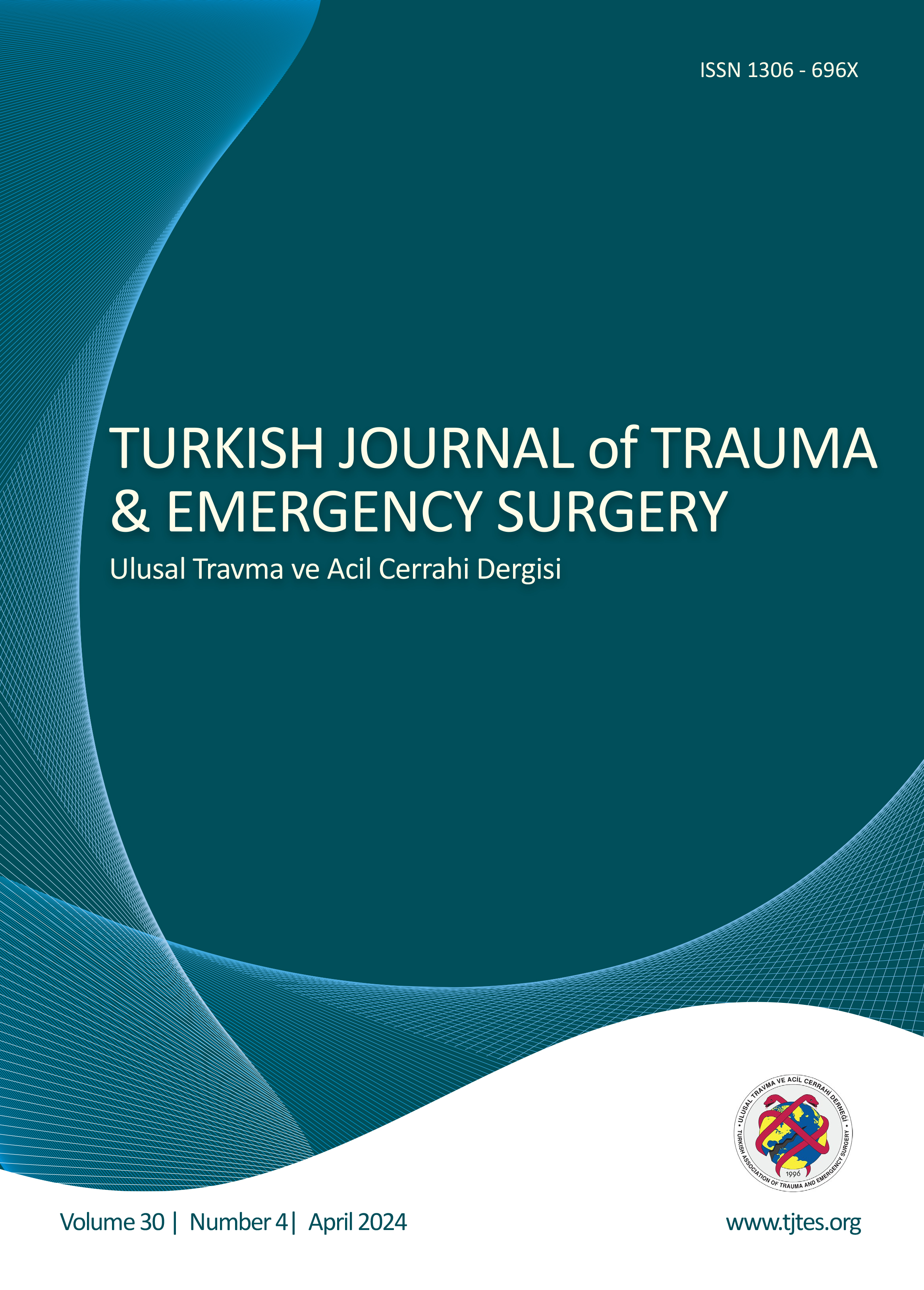Quick Search
Are the systemic immune-inflammation index and panimmune-inflammation value predictive indicators for the decision of operative treatment in adhesive small bowel obstruction?
Burak Uçaner1, Şebnem Çimen1, Muhammed Emin Birgün1, Ahmet Kamburoğlu2, Mehmet Zeki Buldanlı1, Şahin Kaymak1, Oğuz Hançerlioğulları11Department of General Surgery, University of Health Sciences, Gülhane Training and Research Hospital, Ankara,Türkiye2Department of General Surgery, Çankırı State Hospital, Çankırı, Türkiye
BACKGROUND: Emergency surgical pathologies constitute a significant portion of general surgery practice. Small bowel obstructions are a common cause of surgical emergencies in general surgical practice. This study aimed to investigate the predictive role of the Systemic Immune-Inflammation Index and Pan-Immune-Inflammation Value in determining the need for operative treatment in adhesive small bowel obstructions. These obstructions are significant in general surgery, yet clinicians lack consensus on treatment selection and clinical follow-up. This study also seeks to address controversial questions surrounding this topic.
METHODS: The study included patients with small bowel obstruction caused by adhesions during the postoperative period who were treated and followed up in our General Surgery Clinic. Patients' age, demographic information, and clinical data from January 2017 to January 2024 were retrospectively reviewed and recorded using the hospital information management system (HIMS) and patient records. Statistical analyses were performed using SPSS version 22.0.
RESULTS: A total of 341 patients with postoperative adhesive small bowel obstruction were included in the study. The mean age was 59.6±17.4 years (range: 18-93 years), with a male-to-female ratio of 1.4: 1. The median duration of symptoms was 2 days (range: 1-30 days). Operative treatment was performed in 19.6% of cases. The most frequently used operative technique was explorative laparotomy and bridectomy (70.1%). Intensive care unit (ICU) admission was required for 16.1% of patients, and the in-hospital mortality rate was 4.1%. The predictive roles of the Systemic Immune-Inflammation Index (SII), Pan-Immune-Inflammation Value (PIV), and other markers for operative treatment were evaluated. Receiver operating characteristic (ROC) analysis revealed that SII (area under the curve [AUC]=0.601, p=0.009) and PIV (AUC=0.596, p=0.010) were determinants for operative treatment.
CONCLUSION: SII and PIV values may assist in determining the need for operative treatment or non-operative follow-up in patients with adhesive small bowel obstruction (ASBO). By utilizing these markers, unnecessary operative interventions may be avoided. The management strategies for ASBO, a significant component of general surgical emergency practice, remain to be fully clarified. There are ongoing debates in the literature on this subject. We believe further studies with prospective, homogeneous, and broader populations should be conducted to address this issue.
Adheziv ince bağırsak obstrüksiyonlarında operatif tedavi kararının alınmasında Sistemik immün-inflamasyon indeksi ve Pan-immün-inflamasyon değeri prediktör müdür?
Burak Uçaner1, Şebnem Çimen1, Muhammed Emin Birgün1, Ahmet Kamburoğlu2, Mehmet Zeki Buldanlı1, Şahin Kaymak1, Oğuz Hançerlioğulları11Sağlık Bilimleri Üniversitesi, Gülhane Eğitim ve Araştırma Hastanesi, Genel Cerrahi Kliniği, Ankara, Türkiye2Çankırı Devlet Hastanesi, Genel Cerrahi Kliniği, Çankırı, Türkiye
AMAÇ: Acil cerrahi patolojiler genel cerrahi pratiğinin çok önemli bir kısmını oluşturmaktadır. İnce bağırsak obstruksiyonları da genel cerrahi pratiğinde yeri olan acil cerrahi patolojilerin önemli bir sebebidir. Bu çalışma ile birlikte; genel cerrahi pratiğinde önemli yeri olan ve klinisyenlerin tedavi seçimi ve klinik takip hususunda net bir fikir birliğine varamadığı adheziv ince bağırsak obstrüksiyonlarında; Sistemik immün inflamasyon indeksi ve Pan immün inflamasyon değerinin operatif tedavi kararının alınmasında prediktör rolünü araştırmayı ve konu ile ilgili tartışmalı sorulara cevap
bulmayı amaçladık.
GEREÇ VE YÖNTEM: Çalışmaya; Genel Cerrahi Kliniğimizde postoperatif dönemdeki adezyona bağlı ince bağırsak obstrüksiyonu olan ve klinik takip ve tedavisi yapılan hastalar dahil edildi. Ocak 2017 ile Ocak 2024 yılları arasındaki hastalara ait; yaş, demografik ve klinik veriler hastane bilgi yönetim sistemi (HBYS) üzerinden ve hasta kayıtları üzerinden geriye dönük olarak tarandı ve kaydedildi. İstatistiksel analizlerde SPSS versiyon 22.0 kullanıldı.
BULGULAR: Çalışmaya dahil edilen postoperatif adheziv ince bağırsak obstrüksiyonu olan 341 hastanın yaş ortalaması 59.6±17.4 idi (18-93 yaş). Erkek/kadın oranı 1.4/1 idi. Median semptom süresi 2 gündü (1-30 gün aralığında). Olguların %19.6sı operatif olarak tedavi edildi. En sık tercih edilen operatif teknik eksploratif laparotomi+bridektomi (%70.1) idi. Hastaların %16.1i yoğun bakım ünitesine (YBÜ) kabul edildi. Hastane içi mortalite oranı %4.1 idi. Operatif tedavide SII, PIV ve diğer belirteçlerin belirleyiciliği değerlendirildi. ROC analizlerinde, SII (AUC=0.601, p=0.009) ve PIV (AUC=0.596, p=0.010) değerlerinin operatif tedavide belirleyici olduğu izlendi.
SONUÇ: Bu çalışma ile; SII ve PIV değerlerinin AİBO tanılı hastalarda operatif tedavi veya non-operatif takip kararının alınmasında faydalı olabileceği ve bu sayede gereksiz operatif yaklaşımların önüne geçilebileceğini düşünmekteyiz. Genel cerrahi acil pratiğinde çok önemli yeri olan AİBOda hastalara uygulanacak tedavi modaliteleri hala net değildir ve literatürde konu ile ilgili tartışmalar sürmektedir. Konu ile ilgili prospektif, homojen ve daha geniş polülasyonlu çalışmaların yapılması gerektiğini düşünmekteyiz.
Manuscript Language: English



